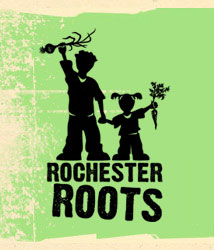
 |
 |
|
Rochester Roots School-Community Garden Project "I learned how to peel and can tomatoes" Rochester Roots works with teachers, students, parents, neighbors, master gardeners and various community partners to transform underutilized schoolyards into urban gardens. Produce grown at the schools is harvested and distributed to students and community members who work in the gardens. Together, we are developing a comprehensive social, educational program, using urban agriculture as the vehicle. It is part of a national movement of school-community gardens integrating culture, nutrition, gardening and ecology studies, and community. Our Director and Garden Project Manager work with community partners to provide workshops, cooking classes, field trips, entrepreneurial training, and hands-on garden experience in teaching about a sustainable food system to our participants. This year-round project teaches elementary school students how to grow organic vegetables, herbs and flowers. During the school year we work primarily with children in kindergarten through 6th grade. In the summer months we work with students of all ages who live within the vicinity of our gardens, including high school interns from the Rochester Landscape Technicians program. "The more experience the children have working in the greenhouse the more they feel confident in contributing during my lessons in geography and botany." Teachers are encouraged to integrate the gardens into their daily lessons by using the wealth of curricular material available that include lesson plans developed in accordance with NYS Learning Standards. Thanks to our three-year Community Food Projects Grant from the US Department of Agriculture, our Resource Librarian was able to work with teachers to recommend and place books in all three schools. These are meant to complement and enhance the hands-on education taking place in the various gardens in each school. We grow heirloom varieties of vegetables as a way of encouraging diversity in the vegetable world and to ensure that rare varieties don�t become extinct. Many of these are 18th and 19th Century varieties that were brought here by immigrants from all parts of the globe. The activities of preserving heirloom seeds and hands-on gardening connect us to history in a way that is both enjoyable and educational. "Students are more enthusiastic about botany in general as well as more knowledgeable about the source of food." Our farm market component teaches participants entrepreneurial skills in food harvesting, packaging, displaying, and innovative marketing. A portion of the produce is sold to local food cooperatives and restaurants. The third component is the development of garden-based products that are sold to the public. Our line of Petal Power and Green Power Skin Salves and Lip Balms developed and made by Rochester Roots School-Community Garden Project participants, is one example of this work. We currently work with three elementary schools: Franklin Montessori School, Clara Barton School #2 and Dr. Martin Luther King, Jr. School #9. All three schools are located in low-income areas in the City of Rochester where food insecurity is high. "As we receive future grants and contributions our hope is to expand this program into additional schools, which furthers our goal of creating a truly sustainable, local food system."
Growing GreenOur participants/students are taught how to start, cultivate, and harvest vegetables herbs and flowers using organic agricultural methods. All the plants we grow are unique in color, shape and flavor�we grow over 40 different vegetable crops and several varieties of each. Some of the organic and sustainable methods we demonstrate are: Benefiting from diversity: Growing a variety of plant species within the same garden encourages a diverse and thriving living environment. Cultivating a number of �beneficial� flowers and herbs attracts butterflies, bees and ladybugs�all of which help to pollinate our vegetable plants and feed on bugs that we don�t want eating our veggies. We teach the interconnectedness of the plant and insect worlds. For example, our "good" bugs need "bad" bugs to eat. Companion planting: Vegetable and herb families have special relationships with each other. For example, some pairings promote healthy and vigorous growth for both; others might inhibit growth. Crop rotation: Growing vegetable families in different garden beds each year discourages potential insect and bacterial damage, and the depletion of vital soil and plant nutrients. This is another way of encouraging diversity. Composting: By recycling vegetative material that is weeded and harvested from the gardens, we return to the earth the nutrients and minerals that are wasted if thrown away. Our compost piles teach a closed-loop system of use and reuse. Cover cropping: Keeping all garden beds covered by a "blanket" of vegetation year-round helps to minimize soil erosion. Cover crops, or �green manures,� contain the minerals our vegetables need to grow, and can be tilled directly into the garden beds when ready to plant again. Mulching: Using taller, leafy plants shades out competing weeds. Spreading straw around the base of plants helps to reduce the need for tedious weeding. Mulching also keeps the soil moist during periods of low rainfall. |
